

Saint George and the Dragon (Uccello) Saint George and the Dragon is a painting by Paolo Uccello dating from around 1470.
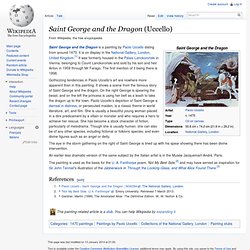
It is on display in the National Gallery, London, United Kingdom.[1] It was formerly housed in the Palais Lanckoroński in Vienna, belonging to Count Lanckoroński and sold by his son and heir Anton in 1959 through Mr Farago. The first mention of it being there is 1898. Gothicizing tendencies in Paolo Uccello's art are nowhere more apparent than in this painting. It shows a scene from the famous story of Saint George and the dragon. Gwyneth Lewis: Writing Poetry. U.A. Fanthorpe Expressing Her Attitude Towards our Education System. Anthology. ‘Education, education, education’ - Notes on Anthology extracts Part One - Poems (the longer texts in Part Two are on a different page.
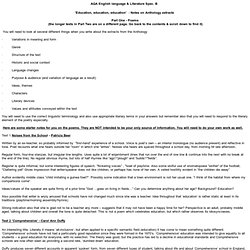
Go back to the contents & scroll down to find it) You will need to look at several different things when you write about the extracts from the Anthology · Variations in meaning and form · Genre · Structure of the text · Historic and social context · Language changes · Purpose & audience (and variation of language as a result) · Ideas, themes · Characters · Literary devices · Values and attitudes conveyed within the text You will need to use the correct linguistic terminology and also use appropriate literary terms in your answers Here are some starter notes for you on the poems. Text 1 Noises from the School Written by an ex-teacher, so probably informed by “first-hand” experience of a school. Regular form, four-line stanzas, but irregular line lengths. Register is quite informal, but some interesting figures of speech.
An interesting title. Student 1 is African . Find IB Analysis of Not my Best Side by U.A. Fanthorpe Coursework and Essays Help from Marked By Teachers.com. International Baccalaureate Languages The first 200 words of this essay...

Analysis of Not my Best Side by U.A. Fanthorpe Not my Best Side, by U.A. Fanthorpe, is a poetical and parody-like interpretation of Paolo Uccello's painting, St. The reason behind Fanthorpe's poem is probably the fact that the slaying is not represented on Uccello's canvas the way that most people would imagine. Read more The above preview is unformatted text. Forms of Poetry - f. Poetry Glossary. Types of Poetry Examples. Learning about the different types of poetry is often easier when you review examples of the different types.
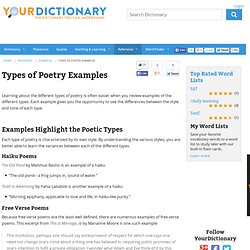
Each example gives you the opportunity to see the differences between the style and tone of each type. Examples Highlight the Poetic Types Each type of poetry is characterized by its own style. By understanding the various styles, you are better able to learn the variances between each of the different types. Haiku Poems The Old Pond by Matshuo Basho is an example of a haiku: “The old pond-- a frog jumps in, sound of water.” Truth in Advertising by Yahia Lababidi is another example of a haiku: “Morning epiphany, applicable to love and life, in haiku-like purity.” Free Verse Poems Because free verse poems are the least well defined, there are numerous examples of free verse poems.
This excerpt from Little Father by Li-Young Lee is another example of free verse poetry: I buried my father in my heart. POETRY FORMS AND TERMINOLOGY. Descriptions and examples of various poetry forms.

(For ASIAN-INSPIRED FORMS and for GLOSSARIES OF LITERARY TERMS, scroll to the lower half of the page.) Abecedarian and Acrostic A brief but sufficient introduction to the two forms, with an example of each plus several links. From Poets.org . Acrostics. Mascara Literary Review. By Associate Professor Paul Sharrad University Of Wollongong Paul Sharrad is Associate Professor in English Literatures at the University of Wollongong where he teaches postcolonial writing and theory.
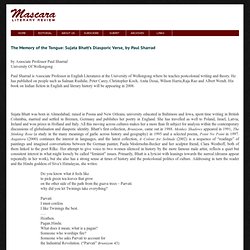
He has published on people such as Salman Rushdie, Peter Carey, Christopher Koch, Anita Desai, Wilson Harris,Raja Rao and Albert Wendt. His book on Indian fiction in English and literary history will be appearing in 2008. Sujata Bhatt was born in Ahmedabad, raised in Poona and New Orleans, university educated in Baltimore and Iowa, spent time writing in British Columbia, married and settled in Bremen, Germany and publishes her poetry in England. She has travelled as well to Poland, Israel, Latvia, Ireland and won prizes in Holland and Italy. Do you know what it feels like to pick green tea-leaves that grow on the other side of the path from the guava trees – Parvati why did you let Twinings take everything? Parvati I must confess I like Twinings the best. …. I can’t hold onto my tongue.
Head of English. This poem is autobiographical in that is recounts a visit made by the poet to a comprehensive school.
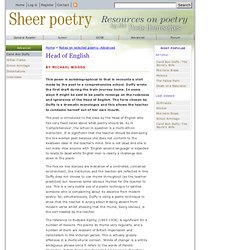
Duffy wrote the first draft during the train journey home. Head of English by Carol Ann Duffy. The opening of King Lear is a cracking bit of family drama.
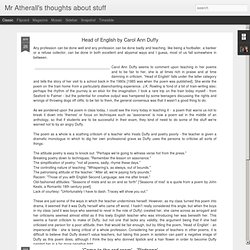
A father, in his last days, is dividing his property between his three daughters. His desire, he claims, is that 'future strife may be prevented now'. He thinks that if he is clear now, then bickering will be prevented in the future. His plan, in theory, seems good, but the problem is that King Lear is an insecure man, desperate to hear words of affirmation from others.
I guess it must be tough being royalty. Rather than simply read his will, he asks his daughters: Which of you shall we say doth love us most? That we our largest bounty may extend Where nature doth with merit challenge. Lear challenges his daughters to 'challenge' each other to see who will get the 'largest bounty' (largest inheritance). The oldest daughter, Goneril, steps up first and hyperbolically declares her love for her father: 'Sir, I love you more than word can wield the matter / Dearer than eye-sight, space and liberty / No less than life'.